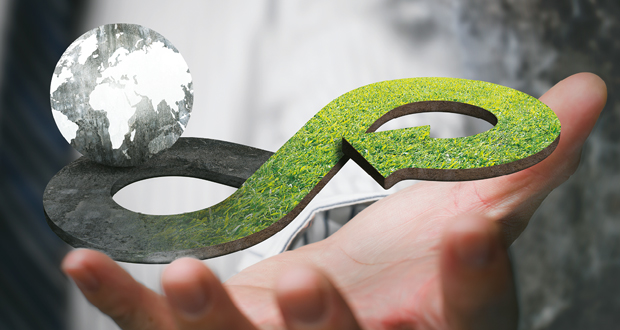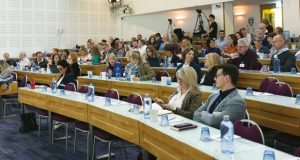CIRCULAR ECONOMY EXAMPLES
Examples of where circular economy principles have become commonplace are within the furniture, IT and flooring sectors while developing models for lighting are also gaining traction. These approaches can also connect to a social value model, whereby social enterprises work to support the reuse programmes described in the examples below.
FLOORING
Interface has been developing a circular approach since 1994, with an ability to reclaim and reuse carpet tiles in new flooring designs; take nylon from old fishing nets and other waste sources to turn into carpet tiles, and has developed a model to take cellulose from wheat to make carpets, which are used for animal bedding at end of life. At the facility in Netherlands, it has achieved:
- Reducing material waste by 80 per cent each year thanks to an ultrasonic cutting machine;
- Reducing gas consumption by up to 45 per cent per sq-m of carpet produced by using a new, more sustainable precoat;
- Recycling up to 600,000 sq m of material each year.
- An Evergreen Services Agreement (ESA) has been proposed – a lease agreement that provides would-be carpet purchasers with comprehensive floor-covering services (colour, texture, warmth, beauty, acoustics, and safety). Under ESA, Interface retains ownership of all carpet material, thereby ensuring proper recycling.
FURNITURE
FaaS (Furniture as a Service) is a commonplace model that allows for leasing of most items, with the potential to upgrade or change products during the course of the lease. Supporting this change, providers are able to offer demountable tables allowing for changes to table sizes and legs to suit changes in the workplace environment. Post-COVID, the ability to modify layouts has been hugely beneficial.
IT
Hardware items, particularly laptops, computers, screens, tablets and other hand-held devices are now available through a leased service model. Companies such as Dell and HP are able to extend the life of these units quite significantly (sometimes to eight years) by upgrading the hardware items at each refresh, whilst keeping 99 per cent of the materials in the chain.
EV BATTERY RECYCLING LOOP
Increasing battery reuse and recycling is increasingly more critical to ensure climate goals are met sustainably and efficiently. Keeping batteries and their metals in circulation for as long as possible reduces our dependency on harmful mining, but provides battery mineral-scarce countries with a steady, low-carbon stream of metals, reducing the reliance on volatile supply chains.
More than a fifth of battery metals used for cell production in UK by 2040 could be from recycling end-of-life batteries. British car companies are now aiming for the UK’s ‘first’ commercial-scale recycling facility for EV battery packs. If a battery passes a certain test, it will be able to be recertified to go back out for energy storage. If not, it will be processed, shredded and the liquid out of it made circular, with plastic split off and will end up with black mass that has four critical minerals – lithium, manganese, cobalt and nickel.
These processes can help to bring down the embedded carbon in the manufacturing process (closer to net zero), and we won’t be reliant on other places for raw materials and components.
CARBON REDUCTION TARGETS
Establishing a circular economy accelerates the process of meeting Paris Agreement climate targets. By its nature, circular economy goods and services will have lower carbon emissions than a linear economy. An estimate from the 2021 Circularity Gap Report claims that a circular economy could reduce global GHG emissions by 39 per cent. This is primarily driven since producing new materials results in emissions, circular economies minimise the need for producing new materials by maximising the reuse of resources, thus eliminating the carbon costs of producing new materials.
For organisations, these carbon impacts will form part of their wider value chain – Scope 3 – emissions, as part of the Purchased Goods and Services. Since these can be up to 70 per cent of FMs impacts, working with suppliers is a critical piece to achieving the stated carbon targets.
The requirement here is to incorporate clauses within procurement specifications that will promote the circular economy approach, and to engage with existing key suppliers on the services they can support in. From an organisational and wider customer perspective, discussions around the potential significant reduction in carbon emissions will allow for a different dialogue to the delivery of FM.
The SFMI Scope 3 Research Project is looking at understanding Scope 3 emissions from FM services in more detail.
For more information, please visit: www.acclaro-advisory.com/sfmi/scope-3-emissions-fm/
BS 8001 has been developed for organisations seeking practical guidance that want to start capitalising on the circular opportunity. It is the first practical framework and guidance of its kind for organisations to implement the principles of the circular economy.
Six basics to the circular economy:
- Systems thinking – understanding the system-wide impacts of your activity
- Innovation – rethinking resource management as a lens for value creation
- Stewardship – taking responsibility for the ripple-effect impacts resulting from your decisions and activities
- Collaboration – securing system-wide benefits by cooperating with others
- Value optimisation – keeping materials at their highest value and function
- Transparency – being open and honest about circular barriers and benefits
Underpinning principles that contribute to a circular economy:
- Dematerialisation – fulfilling demand without the need for a physical artefact, e.g., digital streaming in place of CDs and DVDs
- Designing for resource efficiency – improving the durability of products, designing for disassembly, improved repairability, remanufacturing, modularity and upgradability
- Rethinking business models – “X as a service” and leasing/rental solutions can all help reduce the need for people to own more stuff. IT as a service is a good example
- Technology-led solutions – often labelled the sharing economy, this includes things like peer-to-peer car clubs and exchange platforms like Olio and Too Good To Go
- Prioritising the use of recycled materials in manufacturing, and using the waste products of one industrial process to fuel another – for example beer brewed from surplus bread





